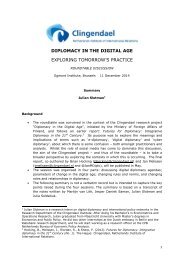BM_IMD_REPORT-How-Authentic-is-your-Corporate-Purpose
BM_IMD_REPORT-How-Authentic-is-your-Corporate-Purpose
BM_IMD_REPORT-How-Authentic-is-your-Corporate-Purpose
Create successful ePaper yourself
Turn your PDF publications into a flip-book with our unique Google optimized e-Paper software.
live the values, determine the strategy and take on the role of ensuring that long-term investment<br />
dec<strong>is</strong>ions reflect the core purpose.<br />
The degree of operational alignment <strong>is</strong> also important in purpose-driven organizations, including<br />
cons<strong>is</strong>tency between brands, purpose, supply chain and marketing. At Unilever, sustainable sourcing<br />
policies guide all dec<strong>is</strong>ions so that they are aligned with purpose. For example, wherever possible,<br />
ingredients are sourced from the country where the food <strong>is</strong> being produced, so that value <strong>is</strong> retained<br />
in the producing country and eco-efficiencies are exploited.<br />
HR practices including recruitment and training are central to attracting and retaining talent that<br />
shares the organizational values and lives the corporate purpose. Toyota ensures that corporate<br />
purpose <strong>is</strong> a key consideration in dec<strong>is</strong>ions at all levels by differentiating between organizational<br />
roles; those in charge of operations have a day-to-day focus while experts are explicitly tasked with<br />
taking a long-term view. In th<strong>is</strong> way, it creates accountability for purpose at the individual level. At<br />
the board level, Toyota’s chairman has also explicitly taken on the role of taking a long-term view.<br />
Google gives employees 20% of their time to work on their own projects, and provides the<br />
opportunity to communicate and articulate how their innovation projects are aligned with corporate<br />
purpose.<br />
Barriers<br />
Half of the companies interviewed cited financial short-term pressures as a barrier to implementing<br />
purpose authentically. Executives referred to pressure to “make the numbers,” as well as consumer<br />
pressure on cost and/or failure to recognize externalities. A few executives mentioned<br />
internationalization as a barrier; as the company globalizes, making sure that local operations and<br />
partners remain aligned with corporate purpose can be a challenge.<br />
In order to overcome these barriers, companies are taking a combination of internal and external<br />
measures.<br />
Internal measures<br />
There are a number of efforts to ensure that human resource (HR) practices, including recruitment,<br />
training, performance evaluation and incentives, are aligned with corporate purpose. Th<strong>is</strong> helps to<br />
mainstream corporate purpose into the organization. When selecting talent, one executive at<br />
Google said, “You need individuals who see the opportunity, are able and willing to connect the<br />
dots, be challenged frequently and be made very uncomfortable.” Some companies (including Tetra<br />
Pak and Unilever) include clear targets to reward contributions to corporate purpose.<br />
A clearly communicated purpose, including how to translate it operationally, helps employees have a<br />
clear mandate for action. A focused message <strong>is</strong> key. While purpose <strong>is</strong> by nature aspirational, it needs<br />
to be real<strong>is</strong>tic and credible.<br />
External measures<br />
Three of the companies interviewed mentioned the importance of engaging with external<br />
stakeholders. For example, Unilever has developed several platforms with external stakeholders.<br />
One such platform <strong>is</strong> the Sustainable Agriculture Initiative Platform, which has 60 food and drink<br />
26








